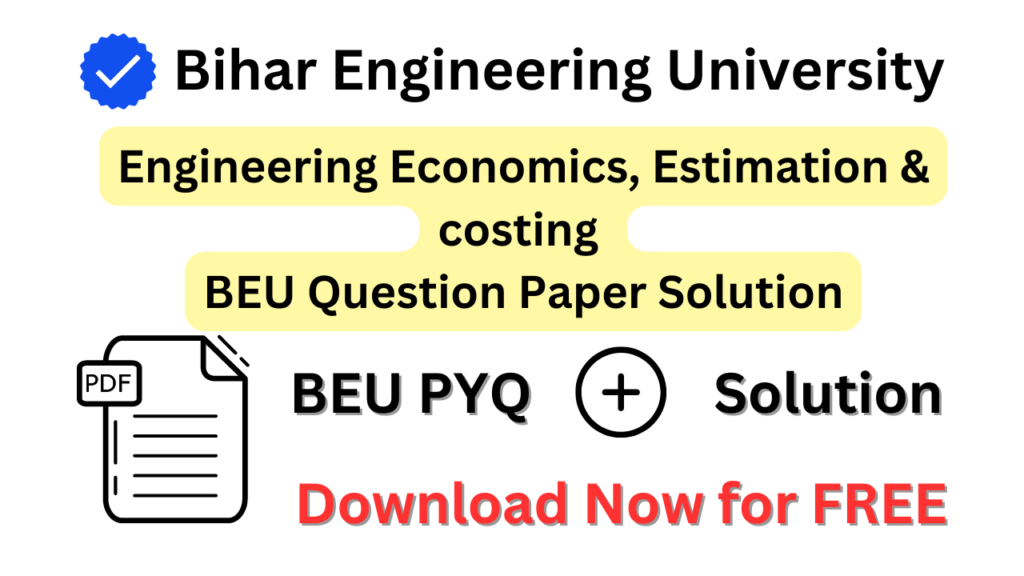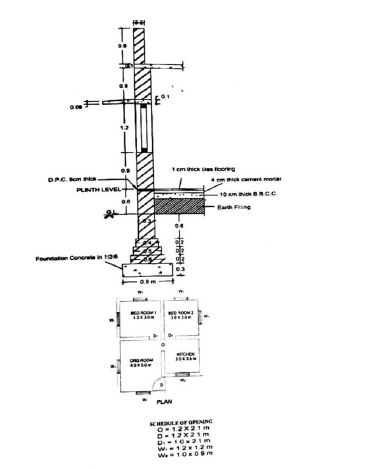BEU PYQ Engineering Economics, Estimation & costing:- In This article, I have provided the solution of Engineering Economics, Estimation & costing BEU Previous year’s question paper along with its Solution that might be similar and high chance of coming in BEU’s upcoming examination. I tried to make the solutions very simple and kept the language easy so that every student could understand it.
Students can easily Download the solution of the Engineering Economics, Estimation & costing Question paper as well as the Engineering Economics, Estimation & costing BEU Question Paper Solution by just clicking on the Download Button available at the bottom of this page.

This Blog is to provide BEU Solutions to past year’s question papers in Engineering Economics, Estimation & costing assisting Students in their exam preparation
Download Engineering Economics, Estimation & costing B.Tech 6th Semester 2024,
BEU PYQ (Previous Years Question) Papers
Download Bihar Engineering University (BEU) Previous Years Question Paper Solution
Instructions:-
(i) The marks are indicated in the right-hand margin.
(ii) There are NINE questions in this paper.
(iii) Attempt FIVE questions in all
(iv) Question No. 1 is compulsory.
Q.1 Choose the correct answer of the following (Any seven question only):
(a) Indian economy is
(i) Socialist Economy
(ii) Gandhian Economy
(iii) Mixed Economy
(iv) Free Economy
(b) The quantity of sand required for RCC (1:2:4) for 15 cubic meters of work is _
(i) 4.76 m3
(ii) 10.32 m3
(iii) 8.43 m3
(iv) 6.51 m3
(c) The rules for measurement of an items are described in
(i) IS 1993
(ii) IS 1896
(iii) IS 1200
(iv) IS 1987
(d) The Centre line method is suitable for walls having.
(i) Different cross-sections
(ii) Similar cross-sections
(iii) Same weights
(iv) Same materials
(e) Purpose of rate analysis is to
(i) Determine current rate of an item
(ii) Market value of an item
(iii) Know the quantities of materials required
(iv) Know the types of labor required
(f) When did the Indian easements Act. 1882, come into force?
(i) 1 April 1883
(ii) 1 March 1882
(iii) 1 July 1882
(iv) 23 April 1883
(g) Which of the following comes under GDP?
(i) Illegal drug sales
(ii) Household work
(iii) An off from work
(iv) Consulting services
(h) If inflation is at 3% and the nominal rate of interest is at 8%. What is the real rate of interest?
(i) 2.4%
(ii) 11%
(iii) 5%
(iv) None of these
(i) Fiscal policy in India is formulated by the
(i) Finance ministry
(ii) RBI
(iii) SEBI
(iv) CSO
(j) The floor area includes the area of the balcony up to
(i) 100%
(ii) 75%
(iii) 50%
(iv) 25%
Q. 2 (a) What is contract and explain various types of contracts.
(b) An RCC beam 400 mm x 800 mm and length 5200 mm is reinforced with 5 no. 20 mm diameter of MS bars placed in one row. Three main bars bent-up. Two i.e., anchor bars of 10 mm diameter are provided at the top. 6 mm diameter stirrups are provided at 200 c/c. The all-round clear cover is 40 mm. Find out the total quantity of steel (plain) bars. Prepare the table of bar bending schedule.
Q.3 (a) Define tender and discuss important points to be included in the tender notice.
(b) Discuss various reasons for rejection of the lowest tender.
Q.4 Determine the following quantity of items of works by considering given drawing of residential building.
(1) Earthwork in excavation for foundation.
(2) Foundation concrete in 1:3:6
(3) Brick Masonry work up to plinth level in C.M. (1:6)

Q.5 (a) Write short notes on
(i) Impact of monetary and fiscal policy on economy
(ii) Use of computers in quantity surveying
(b) Write principles of writing specifications. Write specification for RCC work in 1:1.5:3 for slab
Q.6 (a) What is managerial economics? Briefly explain the techniques of managerial economics.
(b) What is macroeconomics? How does it differ from microeconomics?
Q. 7 (a) Delineate the major challenges in eliminating unemployment and growth retrogress in the Indian economy of recent times. Make brief policy suggestions to meet them.
Q. 8 What do you understand by externalities? Discuss some possible consequences negative externalities .
Q. 9 Explain the factors which affect the analysis of rate. What do you mean by out-turn work? What is called overhead expenses? Determine the rate of centering and shuttering and form work for RCC beam of 8 m length and size (60 cm depth and 30 cm breadth). The rate of timber is रु15,000/- per cu. m. and the rate of prop is रु 45 per rm. Consider, laborer’s as follows:
Head mason-1/8 nos.
Carpenter-2 nos.
Mazdoor-3 nos.
Consider lump sum amount of रु 500/-
The rates of laborer’s are as follows:
Head mason – रु 700/day
Carpenter – रु 2600/day
Mazdoor – रु 400/day
Download All in One Solution of Engineering Economics, Estimation & costing
BEU Question Paper Solution


